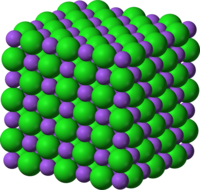
Photo from wikipedia
Recently metal–oxide catalysts have been actively studied, and the catalytic performance strongly depends on the detailed atomic structure at the surface. In addition, the steps or defects on the surface… Click to show full abstract
Recently metal–oxide catalysts have been actively studied, and the catalytic performance strongly depends on the detailed atomic structure at the surface. In addition, the steps or defects on the surface are believed to be particularly important in providing catalytic active sites for catalysis. Here, we report an experimental and theoretical analysis of three kinds of surfaces of single crystal NiO combining aberration corrected TEM and first-principles calculations. Atomic structures of two high Miller index surfaces have been revealed, i.e., a bulk-truncated (112) surface with nickel vacancies in the outermost layer and an oxygen-terminated (113) surface. The analysis of surface structures will help to explain the catalytic mechanisms of NiO catalysts.
Journal Title: Journal of Materials Chemistry C
Year Published: 2020
Link to full text (if available)
Share on Social Media: Sign Up to like & get
recommendations!